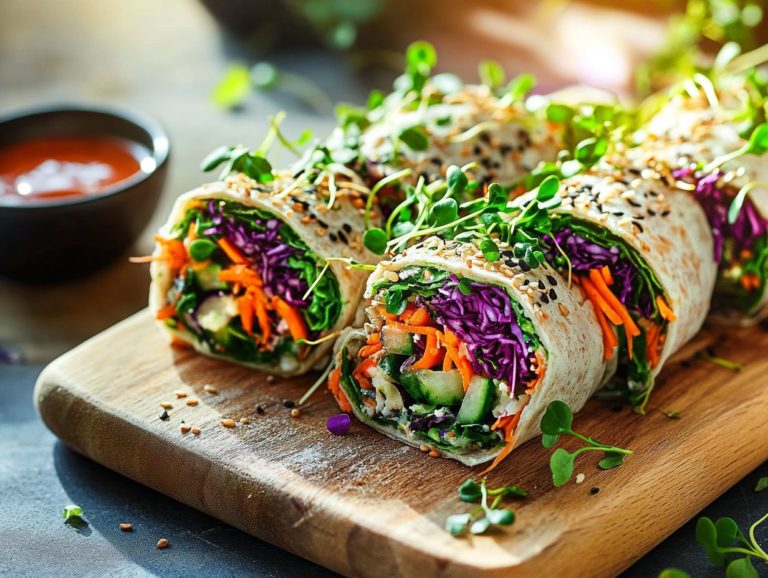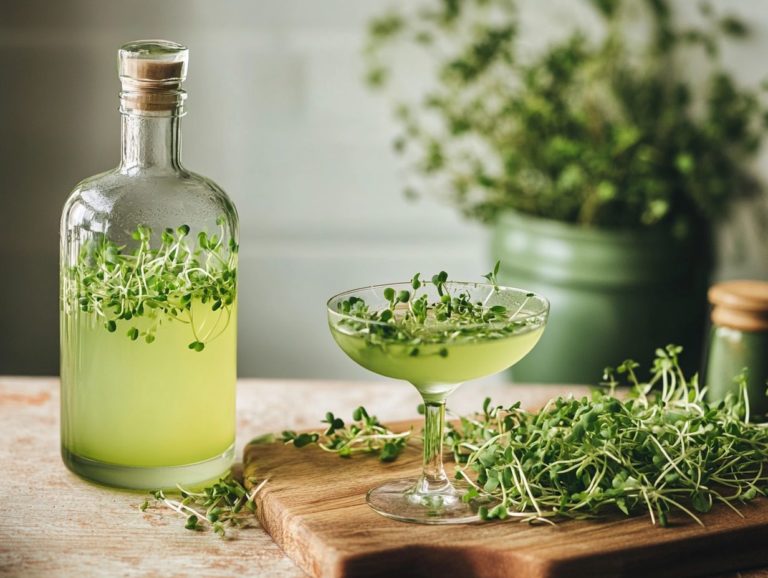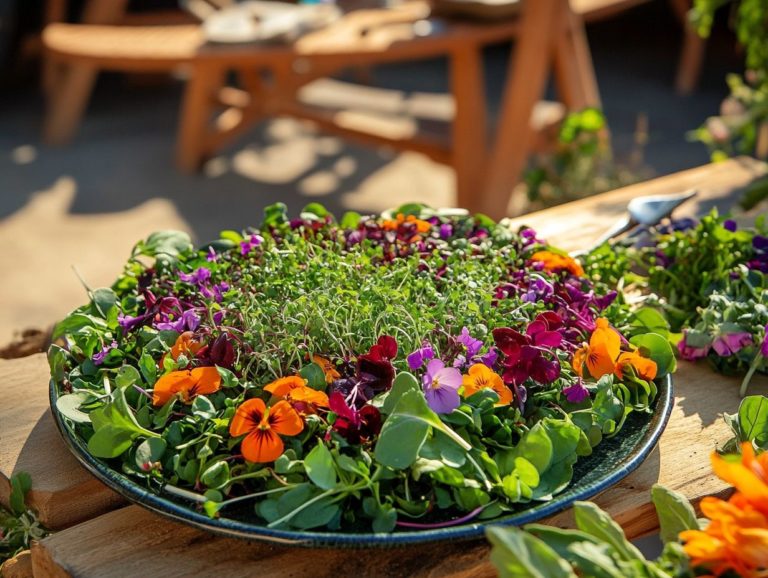39. How to Pair Microgreens with Protein
Incorporating fresh microgreens into your meals adds a vibrant touch that elevates your diet, especially when paired with protein.
These petite greens, also known as food microgreens, are brimming with vitamins and minerals that beautifully complement the essential amino acids found in various protein sources.
This article delves into the significance of protein for a balanced diet while showcasing the remarkable health benefits of salad microgreens.
You ll learn how to choose the ideal pairings, uncover creative recipes, and discover tips to maximize nutrient absorption, ensuring every meal is both delicious and nutritious.
Step into the world of microgreens and protein for a fresher, healthier lifestyle let s get started! Discover how to use microgreens effectively!
Contents
- Key Takeaways:
- The Benefits of Pairing Microgreens with Protein
- Choosing the Right Protein and Microgreens
- Ways to Incorporate Microgreens and Protein Together
- Tips for Maximizing Nutrient Absorption
- Frequently Asked Questions
- How do I choose the right microgreens to pair with protein?
- What types of protein work well with microgreens?
- Can I mix different types of microgreens together when pairing with protein?
- Do I need to cook the microgreens before pairing them with protein?
- How can I incorporate microgreens into my protein dishes?
- Are there any specific flavor pairings I should keep in mind when pairing microgreens with protein?
Key Takeaways:
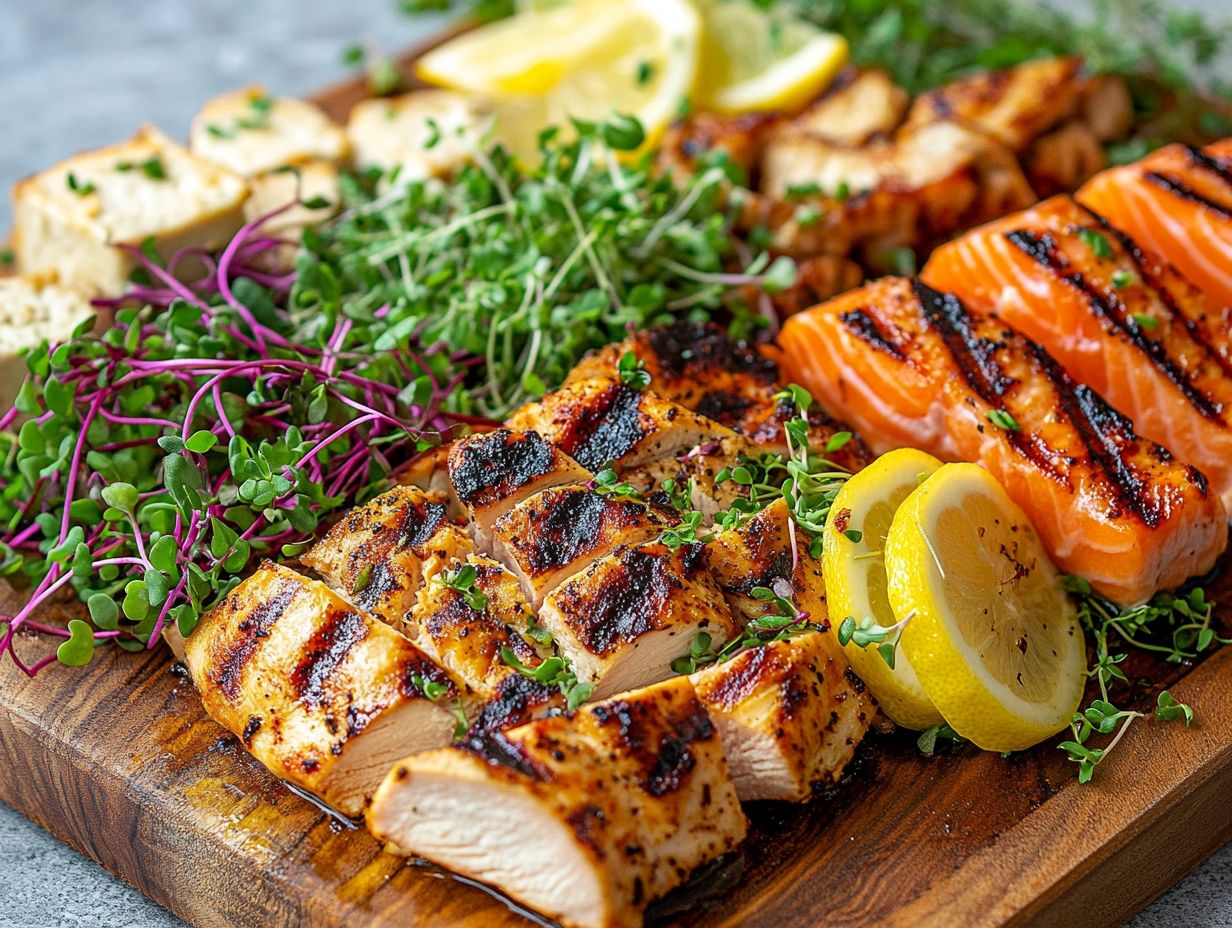
- Pairing microgreens with protein provides numerous health benefits for a balanced diet, especially when considering microgreens recipes.
- Consider factors such as flavor, texture, and nutrient compatibility when choosing the right protein and spicy microgreens to pair together.
- Incorporate microgreens and protein together through microgreens recipes, meals, and creative additions like microgreens pesto to maximize nutrient absorption.
The Benefits of Pairing Microgreens with Protein
Pairing microgreens with protein elevates the flavor profile of your meals while significantly enhancing their health benefits, making them great for microgreens smoothies. These young, nutrient-dense plants like radish microgreens and sunflower shoots are brimming with vitamins, minerals, and antioxidants, including Vitamin C, that harmonize beautifully with protein sources such as lentils, tofu, and cheese.
This thoughtful combination can yield remarkable health benefits, including increased energy levels, improved muscle recovery, and an overall enhancement in microgreens health and well-being.
Incorporating this into your diet not only enriches your meals but also transforms your approach to nutrition, especially with microgreens diet.
Why Protein is Important for a Balanced Diet
Protein stands as a cornerstone of a balanced diet, functioning as the essential building block for muscles, tissues, and enzymes. It plays a pivotal role in muscle repair and overall health.
This vital nutrient not only fuels muscle growth but also significantly contributes to the production of key hormones and enzymes that regulate countless bodily functions. You’ll find that protein helps maintain healthy skin and hair and promotes satiety, aiding in effective weight management.
When you pair it with microgreens, brimming with vitamins and minerals, your meals can transform into nutritional powerhouses, perfect for snacks microgreens. These tiny wonders provide a concentrated source of nutrients that beautifully complement protein sources. For instance, try 5 ways to enjoy microgreens with eggs, amplifying the overall health benefits of your meals and supporting a well-rounded diet.
Nutritional Benefits of Microgreens
Microgreens are a treasure trove of nutrients, offering you a concentrated source of vitamins, minerals, and antioxidants that are essential for maintaining optimal health, making them ideal for microgreens drinks. Varieties like radish microgreens, pea shoots, and sunflower greens are particularly impressive, boasting high levels of vitamin C, vitamin K, and proteins, perfect for vegetable wraps. This makes them a powerful addition to your diet.
By incorporating these vibrant greens into your meals, you not only elevate the flavor but also enhance the nutritional profile of your everyday foods.
For instance, when you add radish microgreens to a fresh salad, you get that delightful spicy kick while also enjoying a boost of antioxidants that support your overall wellness. Similarly, pea shoots can transform a simple sandwich, bringing in a crisp texture and a generous dose of vitamin A, which is essential for eye health.
If you blend sunflower greens into your microgreens smoothies, you ll achieve a creamy consistency while ensuring you’re getting healthy fats and proteins making it easier to fuel your body with the necessary nutrients.
Whether you use them as a garnish or make them the star of your dish, these microgreens effortlessly enhance various meals, turning the ordinary into nutritional powerhouses.
Choosing the Right Protein and Microgreens
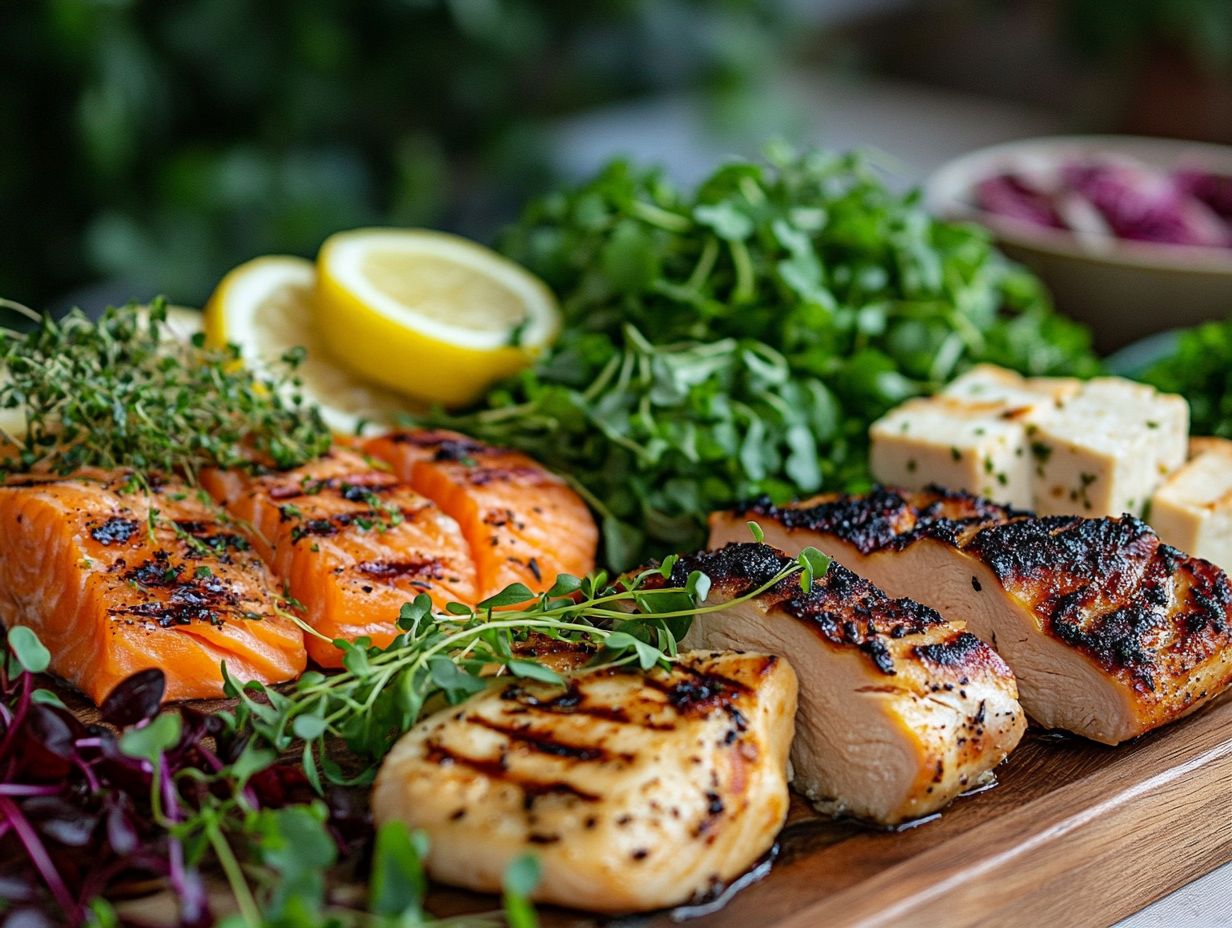
Selecting the ideal protein source to accompany microgreens is crucial for making healthy meals tailored to your dietary preferences. This allows you to add microgreens creatively. Whether you opt for beans, lentils, or animal proteins like chicken and cheese, understanding their nutritional profiles alongside the health benefits of microgreens can elevate your meal planning.
This smart pairing gives you the essential amino acids, the building blocks of protein your body craves, while maximizing the antioxidants and vitamins from those vibrant microgreens, including radish microgreens. For an elevated experience, consider exploring microgreens and cheeses: perfect pairings. The result? Meals that are not only delectable but also align with your health-conscious lifestyle.
Factors to Consider
When selecting the perfect protein to accompany your microgreens, weigh several factors, including your dietary needs, taste preferences, and nutritional content. For instance, if you’re eager to boost your intake of plant-based proteins, legumes like lentils or chickpeas can beautifully complement the kick of spicy microgreens.
If you’re leaning toward animal protein, grilled chicken or cheese paired with fresh arugula microgreens can elevate your meal with delightful flavors.
If you focus on a low-carb lifestyle, consider fatty fish, such as salmon. It pairs exquisitely with vibrant microgreens like pea shoots, delivering a burst of flavor along with essential omega-3 fatty acids.
Quinoa is an excellent gluten-free protein that harmonizes perfectly with the earthy notes of beet microgreens. It’s a great choice for microgreens recipes.
Every pairing not only aligns with specific dietary goals but also enhances your overall dining experience. Explore a range of combinations that nurture both your palate and nutritional needs.
Best Pairings for Optimal Nutrition
For optimal nutrition, consider how certain pairings of microgreens and protein can create a dynamic balance that enhances both flavor and health benefits, especially in microgreens soups. For example, when incorporating spicy microgreens with grilled chicken or steak, you not only introduce a delightful kick but also enrich your meal with antioxidants and essential nutrients.
Combining salad microgreens with tofu or lentils offers a robust plant-based protein option that supports your overall wellness. For some creative ideas, check out 6 ways to use microgreens in salads.
Blending earthy microgreens like beet greens with smoked salmon makes for a luxurious topping on bagels or toast, marrying texture and flavor in a satisfying snack. For a refreshing twist, use pea shoots alongside chickpeas in a vibrant salad. This pairing delivers a sweet crunch while ensuring you get a hefty dose of protein and fiber. For more ideas, check out these creative ways to add microgreens to your meals.
Wraps can also benefit from these pairings. Swiss chard microgreens, for instance, complement turkey or hummus beautifully, elevating the dish nutritionally and tastefully, making it ideal for a meal on the go.
Ways to Incorporate Microgreens and Protein Together
Incorporating microgreens and protein into your meals opens the door to a world of delightful and nutritious possibilities, inviting culinary creativity.
Picture vibrant salads adorned with fresh microgreens and succulent grilled chicken, or hearty soups infused with radish microgreens and hearty beans. The options are endless, allowing you to integrate these nutrient-rich ingredients seamlessly.
Imagine blending microgreens into your smoothies or using them as a zesty topping for sandwiches. Transform every snack into a flavorful experience that boosts your health.
With each meal, you have the chance to elevate both taste and nutrition. Don’t miss out on the endless options!
Recipes and Meal Ideas
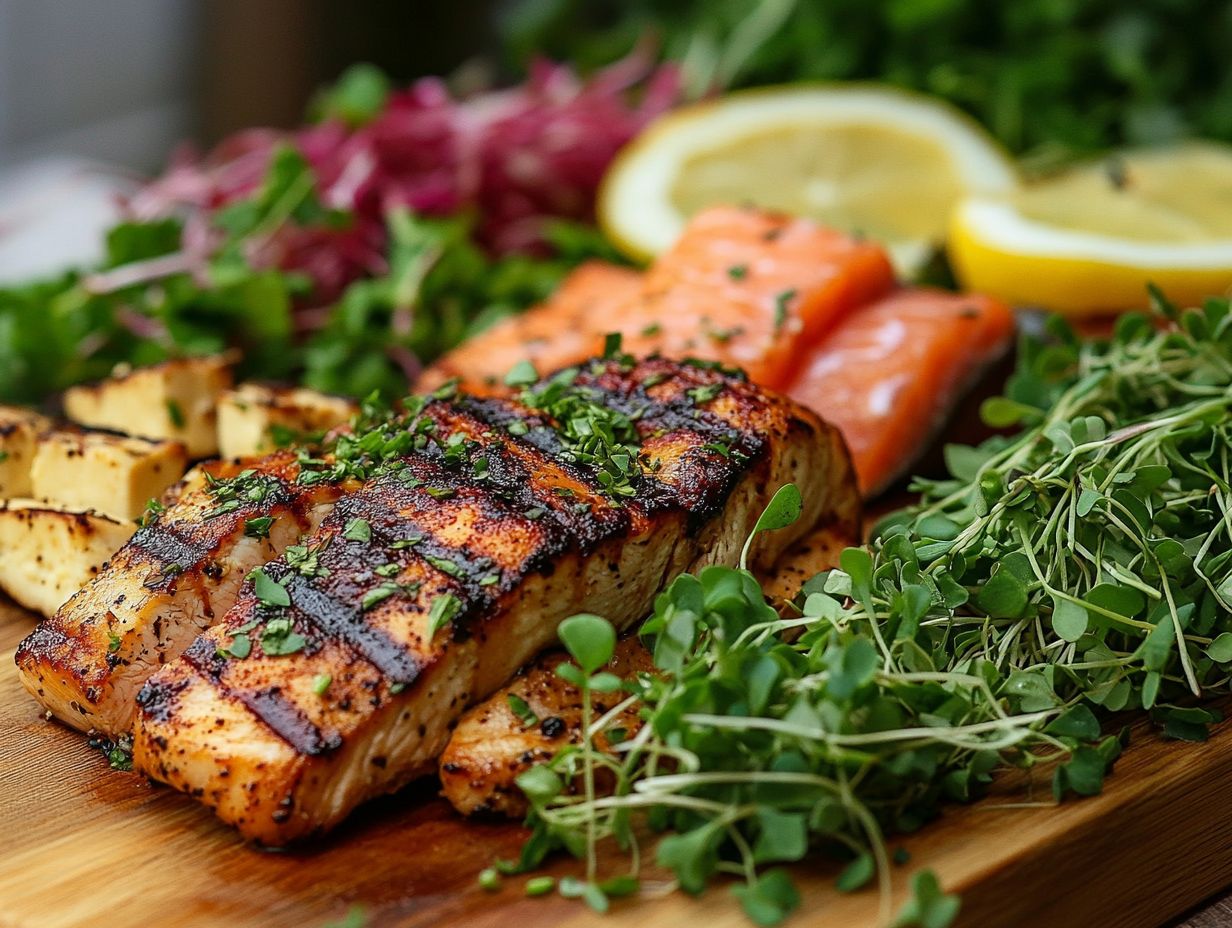
Creating delicious and nutritious recipes that incorporate microgreens and protein can truly elevate your meal planning experience. Imagine a refreshing salad with salad microgreens, grilled tofu, and a zesty citrus dressing perfect for a light yet satisfying lunch.
How about a hearty microgreens soup that warms the soul, brimming with lentils and spices? Blending spicy microgreens into smoothies or using them as toppings for snacks like guacamole can infuse your palate with vibrant flavors and textures. For more ideas, check out cooking with microgreens.
By adding protein sources like chickpeas or quinoa to a grain bowl topped with radish microgreens, you enhance the meal’s nutritional value and create a colorful feast for the eyes. Picture crafting a savory omelette filled with mustard greens and feta cheese for breakfast, or wrapping succulent shrimp with bright pea shoots in whole grain tortillas for a delightful lunch. For an extra boost, consider incorporating the best microgreens for higher protein intake into your meals.
For an easy snack, try mixing cream cheese with sunflower microgreens to create a tasty dip for fresh veggies or adding them to sandwich toppings. Each of these meal ideas showcases the versatility and health benefits of incorporating microgreens, and you can explore more delicious options in best recipes to try without sacrificing flavor.
Creative Ways to Add Microgreens to Your Protein
Finding imaginative ways to incorporate microgreens into your protein dishes can significantly elevate both the flavor and nutritional value of your meals, enhancing your enjoyment of cooking with microgreens.
These vibrant greens aren’t just a feast for the eyes; they introduce a delightful array of distinctive flavors to your culinary creations. For example, when you add sunflower microgreens to your scrambled eggs, you’ll enjoy a nutty taste that complements the dish exquisitely. You can also craft a refreshing homemade pesto using nutrient-rich microgreens instead of the usual basil. This twist enhances both the flavor profile and the health benefits when paired with grilled chicken or shrimp. To take your dishes to the next level, check out this guide on how to incorporate microgreens into casseroles.
Imagine blending pea shoots into creamy dips for your next gathering; they offer a subtle sweetness and earthy note that’s perfect for entertaining. By experimenting with different cooking techniques like sautéing or blending, you can truly showcase the versatility of microgreens. For more ideas, check out cooking tips on microgreens and nutrition, turning your everyday meals into gourmet experiences.
Tips for Maximizing Nutrient Absorption
Maximizing nutrient absorption from your meals is crucial for optimal health, particularly when you combine microgreens with protein. Specific preparation and cooking techniques can significantly enhance the bioavailability of nutrients this means making nutrients more accessible for your body to absorb ensuring you fully reap the benefits of vitamins, minerals, and antioxidants found in both microgreens and protein sources.
For example, lightly steaming microgreens preserves more nutrients than boiling, and pairing them with healthy fats, such as olive oil in dressings, can further boost nutrient uptake.
Preparation and Cooking Techniques
Employing the right preparation and cooking techniques is crucial for preserving the nutrient density of microgreens while pairing them with protein sources. To maximize health benefits, consider methods like saut ing or adding microgreens raw to your dishes; these techniques help retain essential vitamins and antioxidants while enhancing the overall flavor profile.
Incorporating microgreens at the end of the cooking process helps maintain their vibrant texture and nutritional quality. For instance, when preparing a stir-fry, add the microgreens just before serving to prevent wilting and nutrient loss.
Pair them with grilled chicken or fish, allowing those subtle flavors to shine through while keeping your dish light. Alternatively, try tossing microgreens into a fresh salad topped with roasted proteins; this not only preserves their crunchiness but also elevates the meal’s visual appeal. For more ideas, check out this guide on how to pair microgreen varieties with dishes.
To ensure the longevity of their nutrients, store microgreens in a cool, dry place and consume them shortly after harvesting. This way, your meals remain both nutritious and delightful.
Start experimenting with these exciting meal ideas today and savor the health benefits!
Frequently Asked Questions
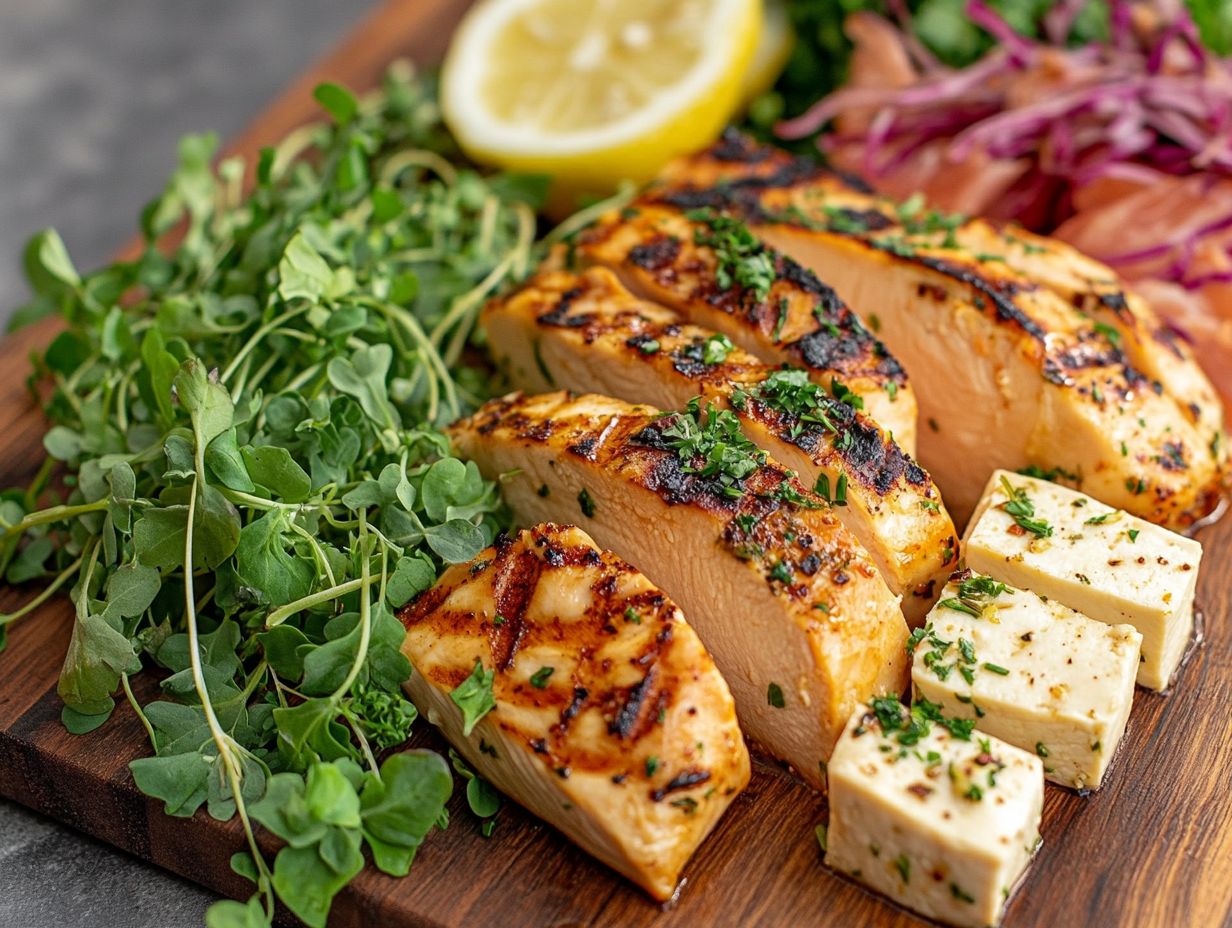
How do I choose the right microgreens to pair with protein?
Choose microgreens with strong flavors that hold up well when cooked. Good options include arugula, cress, and radish microgreens.
What types of protein work well with microgreens?
Chicken, fish, and tofu pair excellently with microgreens. They offer a balanced flavor and texture alongside the delicate greens.
Can I mix different types of microgreens together when pairing with protein?
Yes, mixing microgreens adds complexity to your dish. Balance flavors and textures for a harmonious pairing.
Do I need to cook the microgreens before pairing them with protein?
No, cooking microgreens is not necessary. Many are best enjoyed raw to maintain their delicate flavors and nutrients.
How can I incorporate microgreens into my protein dishes?
You can use microgreens in many ways. Top your protein, mix them into a salad, or blend them into pesto for added flavor and nutrients.
Are there any specific flavor pairings I should keep in mind when pairing microgreens with protein?
There are no strict rules, but some great pairings exist. Try spicy microgreens with grilled meats, or citrusy ones with seafood. Experiment and discover delicious flavor combinations that excite your palate!



